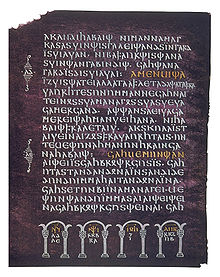Wulfilabible
The Wulfilabibel , also known as the Gothic Bible , is a translation of the New Testament into Gothic created by Bishop Wulfila (311–383) in the 4th century , with the Greek Bible as the model. Wulfila invented the Gothic script for this translation , while the Goths used runes until then . The translation was made in Nicopolis ad Istrum in what is now Bulgaria . It is the main source of the Gothic language.
Several manuscripts from the 6th to 8th centuries with a large part of the New Testament and small parts of the Old Testament have survived from the Wulfilabibel , most of which come from Italy. These manuscripts are the Codex Argenteus (Gospels), today mostly kept in the University Library in Uppsala , the Codex Ambrosianus A to Codex Ambrosianus E (letters, Skeireins , Nehemia ), the Codex Carolinus ( Roman letters ), the Codex Vaticanus Latinus 5750 (Skeireins), the Codex Gissensis (rubble of the Gospel of Luke ) and the Fragmenta Pannonica , fragments of a 1 mm thick metal plate with verses from the Gospel of John .
Some books that are important for the development of the Church, such as the Acts of the Apostles , do not appear in the Wulfilabibel.
Apart from fragmentary runic inscriptions, the Wulfilabibel is the oldest written evidence of a Germanic language and is therefore very important for the history of language.
Text of the Lord's Prayer ( Mt 6,9-13 EU ) in the Wulfilabibel (þ as English th):
- atta unsar þu ïn himinam
- christmas namo þein.
- qimai þiudinassus þone.
- wairþai wilja þeins.
- swe ïn himina jah ana airþai
- hlaif unsarana þana sinteinan gif us himma daga.
- jah aflet us þatei skulans sijaima.
- swaswe jah knows afletam þaim skulam unsaraim.
- jah ni briggais uns ïn fraistubnjai
- ak lausei us af þamma ubilin.
- below þeina ïst þiudangardi.
- jah mahts jah wulþus ïn aiwins.
- Amen
This text, but Scriptio continua , can be found in the Codex Argenteus on leaves 4 v (last line) and 5 r (lines 1 to 12).
output
- Wilhelm Streitberg (ed.): The Gothic Bible. Vol. 1. The Gothic text and its Greek model. Winter, Heidelberg 1908-1910, 2000 (7th edition), ISBN 3-8253-0745-X
literature
- Elfriede Stutz: The New Testament in Gothic language. In: The Old Translations of the New Testament, the Church Fathers Quotes, and Lectionaries - The Current State of Their Research and Their Significance for Greek Textual History , Kurt Aland (ed.). Work on New Testament text research , 5. Berlin - Boston, de Gruyter, 1972 (Reprint 2011). ISBN 978-3-11-082701-9 . Pp. 375-402
- Piergiuseppe Scardigli: Early Bible Translations: Gothic . In: Harald Kittel (Ed.) Translation-Translation-Traduction: An International Encyclopedia of Translation Studies , Berlin / New York, Mouton de Gruyter, 2007, ISBN 978-3-11-020328-8 , pp. 2363-2366 (handbooks linguistics and communication studies 26, 2)
Web links
- Text of the Wulfilabibel (very well prepared)
- Smaller Gothic fragments
- Codex Argenteus Online , full scan of the original in Uppsala
